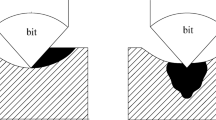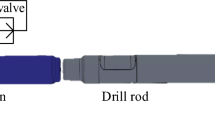Abstract
Drilling machines using the top hammer drilling method incorporate a drilling mechanism whereby the torque and percussive force generated by the hydraulic drifter are transferred to the rock surface through a rod and drill bit. To date, mainstream studies of the hydraulic drifter addressed the behavior of the elastic waves produced by the impact and the drilling characteristics related to rock properties. Meanwhile, studies of design sensitivity analysis and percussion performance improvement for the development of a high-efficiency hydraulic drifter have been insufficient. In this study, to develop a high-efficiency hydraulic drifter, the validity of a model was verified by comparing the test results with a previously constructed analysis model. In addition, using the model, the supply pressure and inlet flow rate, stroke regulator opening, and striking piston’s acting area and mass were selected as the design parameters affecting the percussion performance; through the impact frequency and impact energy, the percussion performance was analyzed. As a result, design values that improve the percussion performance were derived.
Similar content being viewed by others
References
Jimeno, E. L., Jimino, C. L., and Carcedo, A., “Drilling and Blasting of Rocks,” CRC Press, pp. 8–15, 1995.
Lundberg, B., “Computer Modeling and Simulation of Percussive Drilling of Rock,” Comprehensive Rock Engineering, Vol. 4, pp. 137–154, 1993.
Oh, J.-Y., Lee, G.-H., Kang, H.-S., and Song, C.-S., “Modeling and Performance Analysis of Rock Drill Drifters for Rock Stiffness,” Int. J. Precis. Eng. Manuf., Vol. 13, No. 12, pp. 2187–2193, 2012.
Hustrulid, W. A. and Fairhurst, C., “A Theoretical and Experimental Study of the Percussive Drilling of Rock Part I- Theory of Percussive Drilling,” International Journal of Rock Mechanics and Mining Sciences & Geomechanics Abstracts, Vol. 8, No. 4, pp. 311–333, 1971.
Hustrulid, W. A. and Fairhurst, C., “A Theoretical and Experimental Study of the Percussive Drilling of Rock Part II- Force-Penetration and Specific Energy Determinations,” International Journal of Rock Mechanics and Mining Sciences & Geomechanics Abstracts, Vol. 8, No. 4, pp. 335–356, 1971.
Hustrulid, W. A. and Fairhurst, C., “A Theoretical and Experimental Study of the Percussive Drilling of Rock Part III- Experimental Verification of the Mathematical Theory,” in International Journal of Rock Mechanics and Mining Sciences & Geomechanics Abstracts, Vol. 9, No. 3, pp. 417–418, 1972.
Hustrulid, W. A. and Fairhurst, C., “A Theoretical and Experimental Study of the Percussive Drilling of Rock Part IV- Application of the Model to Actual Percussion Drilling,” International Journal of Rock Mechanics and Mining Sciences & Geomechanics Abstracts, pp. 431–442, 1972.
Wu, C., “An Analytical Study of Percussive Energy Transfer in Hydraulic Rock Drills,” Mining Science and Technology, Vol. 13, No. 1, pp. 57–68, 1991.
Chiang, L. E. and Elias, D. A., “A 3D FEM Methodology for Simulating the Impact in Rock-Drilling Hammers,” International Journal of Rock Mechanics and Mining Sciences, Vol. 45, No. 5, pp. 701–711, 2008.
Song, C.-H., Kwon, K.-B., Cho, M.-G., Oh, J.-Y., Shin, D.-Y., and Cho, J.-W., “Development of Lab-Scale Rock Drill Apparatus for Testing Performance of a Drill Bit,” Int. J. Precis. Eng. Manuf., Vol. 16, No. 7, pp. 1405–1414, 2015.
Bu, C., Qu, Y., Cheng, Z., and Liu, B., “Numerical Simulation of Impact on Pneumatic DTH Hammer Percussive Drilling,” Journal of Earth Science, Vol. 20, No. 5, pp. 868–878, 2009.
Franca, L. F. P., “A Bit–Rock Interaction Model for Rotary–Percussive Drilling,” International Journal of Rock Mechanics and Mining Sciences, Vol. 48, No. 5, pp. 827–835, 2011.
Thuro, K., “Drillability Prediction: Geological Influences in Hard Rock Drill and Blast Tunnelling,” Geologische Rundschau, Vol. 86, No. 2, pp. 426–438, 1997.
Giuffrida, A. and Laforgia, D., “Modelling and Simulation of a Hydraulic Breaker,” International Journal of Fluid Power, Vol. 6, No. 2, pp. 47–56, 2005.
Ficarella, A., Giuffrida, A., and Laforgia, D., “Numerical Investigations on the Working Cycle of a Hydraulic Breaker: Off-Design Performance and Influence of Design Parameters,” International Journal of Fluid Power, Vol. 7, No. 3, pp. 41–50, 2006.
Ficarella, A., Giuffrida, A., and Laforgia, D., “Investigation on the Impact Energy of a Hydraulic Breaker,” SAE Technical Paper, No. 2007-01-4229, 2007.
Ficarella, A., Giuffrida, A., and Laforgia, D., “The Effects of Distributor and Striking Mass on the Performance of a Hydraulic Impact Machine,” SAE Technical Paper, No. 2008-01-2679, 2008.
Author information
Authors and Affiliations
Corresponding author
Rights and permissions
About this article
Cite this article
Oh, Jy., Song, Ch., Kim, DJ. et al. Numerical investigation of performance of hydraulic percussion drifter. Int. J. Precis. Eng. Manuf. 17, 879–885 (2016). https://doi.org/10.1007/s12541-016-0107-8
Received:
Revised:
Accepted:
Published:
Issue Date:
DOI: https://doi.org/10.1007/s12541-016-0107-8




